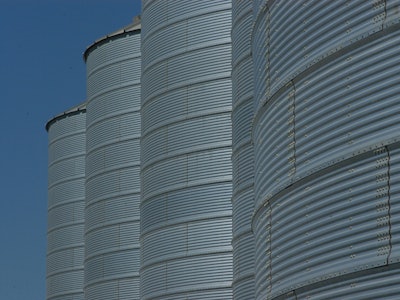
Up to 10% of the U.S. grain crop gets destroyed every yearbecause of post-harvest insect infestations. In a competitive market where quality standards continue to rise, damaged grain is not an option.
There are steps producers can take to help protect stored grains throughout the storage process. Utilizing a comprehensive integrated pest management program that includes treating empty bins with stored grain protectant products will put you in the best shape to maintain grain quality and protect your profits throughout the post-harvest storage process.
An effective integrated pest management program includes cleaning and sanitizing empty grain bins, loading commodities into storage properly, periodic aeration, and regular monitoring, supported by the use of grain protectant products throughout the process.

Cleaning and Sanitizing Empty Grain Bins
Stored grain insects stick around in often overlooked places, such as trace grains from previously stored commodities and in cracks and crevices. Thoroughly cleaning bins is crucial to remove all traces of previously stored grains. This will help keep your grain protected from common pests, including weevils, which are notorious for sticking around.
Weevil larvae actually grow inside sealed grain kernels, making them nearly impossible to spot until they eat their way out of the kernels and become adults. This means any infected trace grains that appear healthy to the naked eye could contain an underlying weevil problem just waiting to spread to your newly stored commodity.
Once bins or storage sites are completely empty, it’s time for a deep cleaning and sanitation regimen. To ensure a deep clean, the following questions can provide a useful guide:
- Is it possible to determine which commodity was last stored in your bin or at your storage site? Don’t forget to clean grain handling equipment too, including all transportation vehicles.
- 你做了所有必要的维修吗?留个心眼啊ut for any space that needs repairing. Make sure to patch and seal any cracks, crevices and holes in your facility, as these are typically how grain insects get into storage. In addition, remember to check the spaces where grain can accumulate, including false doors and augers.
- How does the outside of the grain bin or storage site look? Is the surrounding area clean and free from any signs of your old stored commodity? To help ward off unwanted grain insects from storage, clear the area up to 10 feet around empty bins, clearing weeds and old grains, as those can attract grain insects like granary, maize, and rice weevils, Indian meal moths and more.

Using a Pre-Bin Treatment
Once bins are cleaned and sanitized, repairs have been made, and the area surrounding your storage site has also been cleared of trace grains, it’s time to spray your empty bins with a pre-bin treatment.
By selecting the right products for your operation, you can provide your stored commodities another layer of protection from stored grain insects. TheBug Free Grains lineupfrom Central Life Sciences includes a variety of products including insect growth regulators (IGRs), synergists, insecticides and combination products. Designed for use during the sanitation and grain storage process, these products are available in different formulations that allow for an array of application methods.
We recommend using a comprehensive insect control solution, likeDiacon®IGRPLUSorGravista®Insecticide.
Let’s take a closer look at a few of the productsBug Free Grainshas to offer that work particularly well for treating empty bins prior to loading grain into storage.
- Diacon®-D IGRis a dry formulated product that was designed for use on water-challenged operations, for use where water is scarce.Diacon®-D IGRis a ready-to-use option for controlling insects at on-farm and off-premise storage sites.
- Diacon®IGRPLUSis a versatile liquid formulation that can be used by itself or tank-mixed with a synergist likePBO-8®Synergist.Diacon®IGRPLUSis ideal for treating empty bins and warehouses for stored product insect control.
- Central Life Sciences has also recently introducedGravista®Insecticideto the market. Featuring 3-in-1 insect control with an adulticide, an insect growth regulator and a synergist,Gravista®Insecticidekills labeled insects and breaks their life cycles without the need to tank-mix.
Product Application
From insect growth regulators, to synergists and insecticides, the versatileBug Free Grains lineupfrom Central Life Sciences is available in liquid and dry formulations. Maintaining a strong sanitation program along with using grain protectant products can help control post-harvest insect damage.
For more information on implementing a pre-bin treatment strategy, visitbugfreegrains.com.
Diacon, Gravista, and PBO-8 are registered trademarks of Wellmark International.

